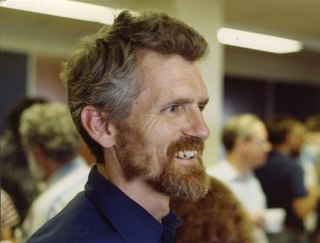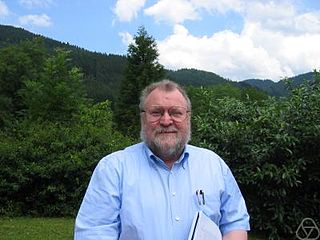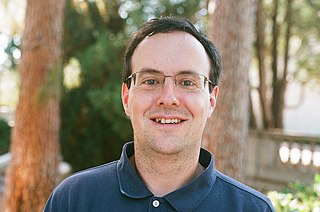In mathematics, a symplectomorphism or symplectic map is an isomorphism in the category of symplectic manifolds. In classical mechanics, a symplectomorphism represents a transformation of phase space that is volume-preserving and preserves the symplectic structure of phase space, and is called a canonical transformation.

Andreas Floer was a German mathematician who made seminal contributions to symplectic topology, and mathematical physics, in particular the invention of Floer homology. Floer's first pivotal contribution was a solution of a special case of Arnold's conjecture on fixed points of a symplectomorphism. Because of his work on Arnold's conjecture and his development of instanton homology, he achieved wide recognition and was invited as a plenary speaker for the International Congress of Mathematicians held in Kyoto in August 1990. He received a Sloan Fellowship in 1989.
In mathematics, Floer homology is a tool for studying symplectic geometry and low-dimensional topology. Floer homology is a novel invariant that arises as an infinite-dimensional analogue of finite-dimensional Morse homology. Andreas Floer introduced the first version of Floer homology, now called Lagrangian Floer homology, in his proof of the Arnold conjecture in symplectic geometry. Floer also developed a closely related theory for Lagrangian submanifolds of a symplectic manifold. A third construction, also due to Floer, associates homology groups to closed three-dimensional manifolds using the Yang–Mills functional. These constructions and their descendants play a fundamental role in current investigations into the topology of symplectic and contact manifolds as well as (smooth) three- and four-dimensional manifolds.
In mathematics, the Weinstein conjecture refers to a general existence problem for periodic orbits of Hamiltonian or Reeb vector flows. More specifically, the conjecture claims that on a compact contact manifold, its Reeb vector field should carry at least one periodic orbit.
In the mathematical field of symplectic topology, Gromov's compactness theorem states that a sequence of pseudoholomorphic curves in an almost complex manifold with a uniform energy bound must have a subsequence which limits to a pseudoholomorphic curve which may have nodes or "bubbles". A bubble is a holomorphic sphere which has a transverse intersection with the rest of the curve. This theorem, and its generalizations to punctured pseudoholomorphic curves, underlies the compactness results for flow lines in Floer homology and symplectic field theory.

Yakov Matveevich Eliashberg is an American mathematician who was born in Leningrad, USSR.

Michael Rapoport is an Austrian mathematician.

Johannes Jisse (Hans) Duistermaat was a Dutch mathematician.

Jean-Claude Sikorav is a French mathematician. He is professor at the École normale supérieure de Lyon. He is specialized in symplectic geometry.
In mathematics, the Conley–Zehnder theorem, named after Charles C. Conley and Eduard Zehnder, provides a lower bound for the number of fixed points of Hamiltonian diffeomorphisms of standard symplectic tori in terms of the topology of the underlying tori. The lower bound is one plus the cup-length of the torus (thus 2n+1, where 2n is the dimension of the considered torus), and it can be strengthen to the rank of the homology of the torus (which is 22n) provided all the fixed points are non-degenerate, this latter condition being generic in the C1-topology.

Eduard J. Zehnder is a Swiss mathematician, considered one of the founders of symplectic topology.
Geometric mechanics is a branch of mathematics applying particular geometric methods to many areas of mechanics, from mechanics of particles and rigid bodies to fluid mechanics and control theory.
François Lalonde is a Canadian mathematician, specializing in symplectic geometry and symplectic topology.

Ana M. L. G. Cannas da Silva is a Portuguese mathematician specializing in symplectic geometry and geometric topology. She works in Switzerland as an adjunct professor in mathematics at ETH Zurich.
Christopher Bishop is an American mathematician on the faculty at Stony Brook University. He received his bachelor's in mathematics from Michigan State University in 1982, going on from there to spend a year at Cambridge University, receiving at Cambridge a Certificate of Advanced Study in mathematics, before entering the University of Chicago in 1983 for his doctoral studies in mathematics. As a graduate student in Chicago, his advisor, Peter Jones, took a position at Yale University, causing Bishop to spend the years 1985–87 at Yale as a visiting graduate student and programmer. Nonetheless, he received his PhD from the University of Chicago in 1987.
Ivan Smith is a British mathematician who deals with symplectic manifolds and their interaction with algebraic geometry, low-dimensional topology, and dynamics. He is a professor at the University of Cambridge.
Dietmar Arno Salamon is a German mathematician.

Jean E. Lannes is a French mathematician, specializing in algebraic topology and homotopy theory.
Luigi Chierchia is an Italian mathematician, specializing in nonlinear differential equations, mathematical physics, and dynamical systems.

Denis Auroux is a French mathematician working in geometry and topology.
This page is based on this
Wikipedia article Text is available under the
CC BY-SA 4.0 license; additional terms may apply.
Images, videos and audio are available under their respective licenses.









